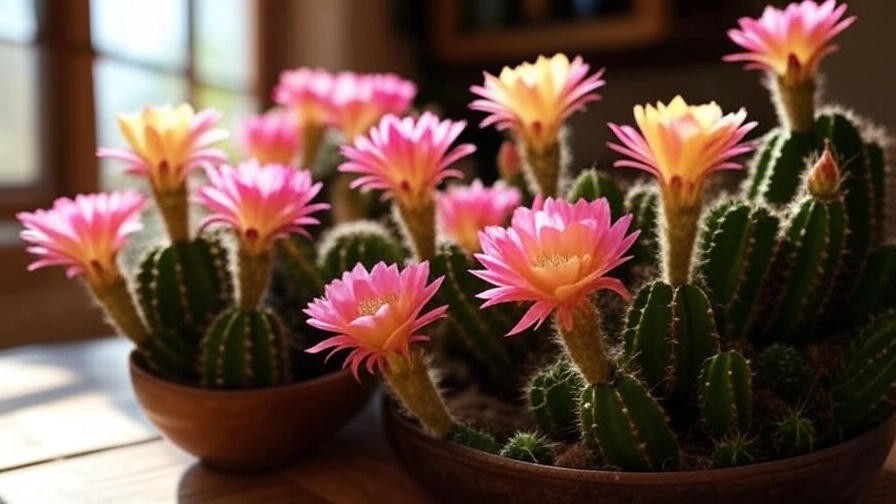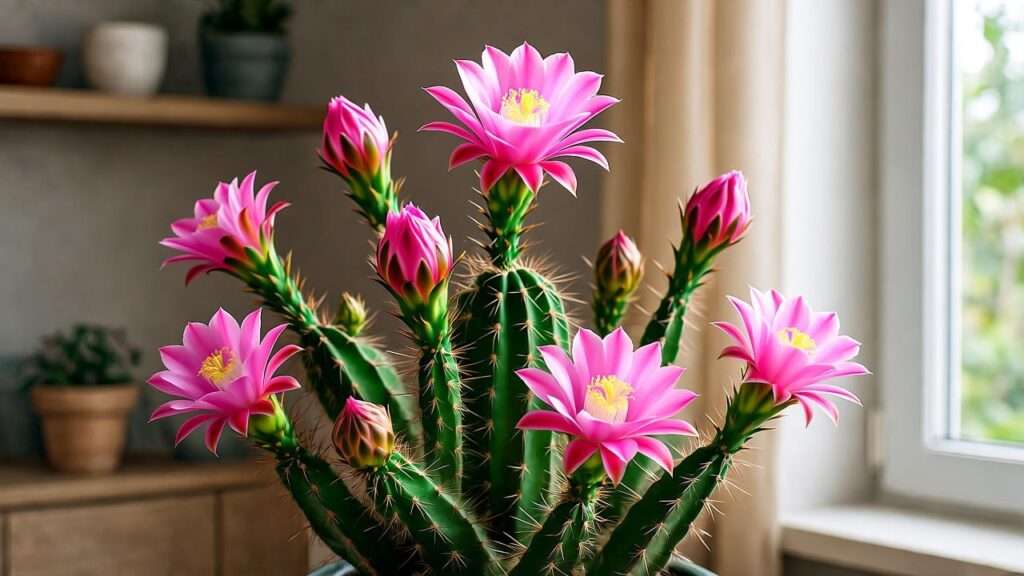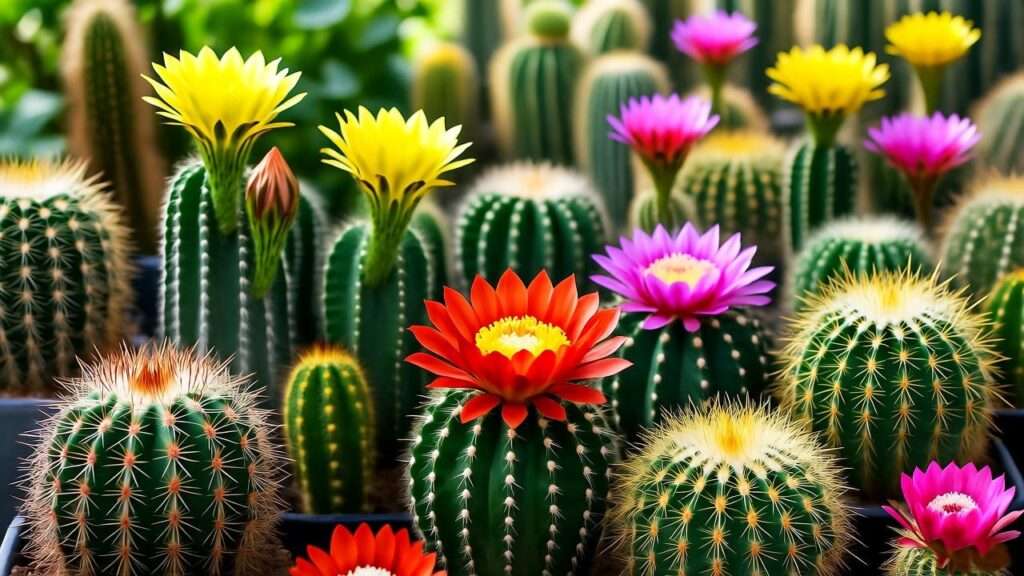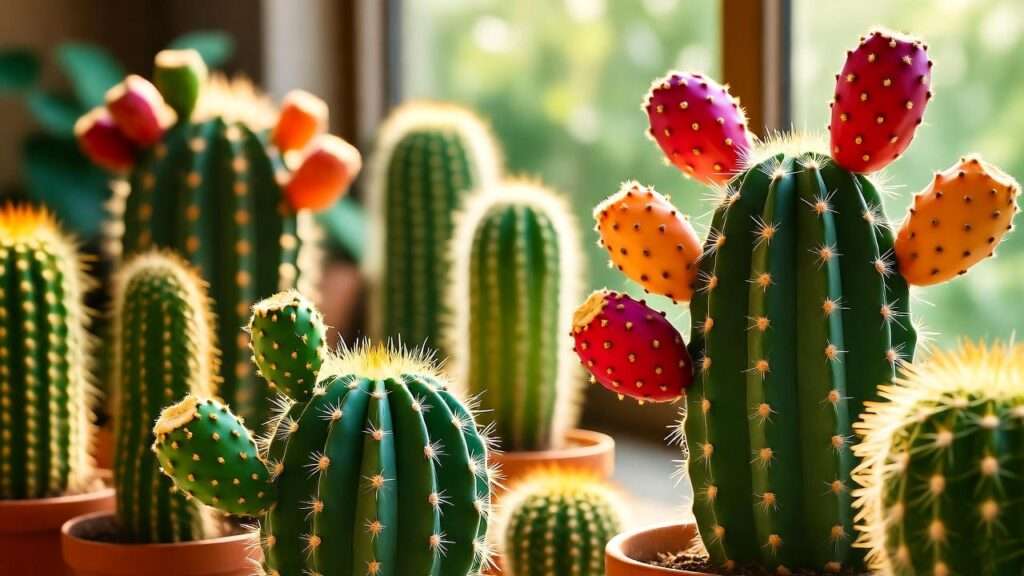Imagine a plant that’s as quirky as it is captivating, dangling like a fluffy, green monkey’s tail from a hanging basket, instantly stealing the show in your indoor jungle. The monkey tail cactus (Cleistocactus colademononis) is that plant—a low-maintenance, visually striking succulent that’s perfect for beginners and seasoned plant enthusiasts alike. Its soft, hair-like spines and trailing growth make it a standout addition to any home, offering both charm and ease of care. Whether you’re new to indoor plants or looking to expand your collection, this guide provides expert-backed, actionable tips to help you grow a thriving monkey tail cactus. From ideal lighting to propagation secrets and troubleshooting common issues, we’ll cover everything you need to nurture this desert beauty with confidence.
In this comprehensive guide, we’ll dive into the unique characteristics of the monkey tail cactus, its care requirements, creative display ideas, and solutions to common problems. Backed by horticultural expertise and practical experience, this article is designed to be your go-to resource for cultivating a healthy, stunning cactus that elevates your indoor space.
What Is a Monkey Tail Cactus?

Overview and Unique Characteristics
The monkey tail cactus, scientifically known as Cleistocactus colademononis, is a trailing succulent native to the arid highlands of Bolivia. Its long, cylindrical stems are covered in soft, white, hair-like spines that give it a fuzzy appearance, resembling a monkey’s tail—hence the name. These stems can grow up to 3–4 feet long, making it a dramatic choice for hanging planters or elevated shelves. Unlike many cacti, its spines are harmless to the touch, making it safe for homes with curious pets or children.
This cactus is a favorite among indoor plant enthusiasts due to its forgiving nature and minimal care requirements. It thrives in conditions that mimic its native desert environment—bright light, well-draining soil, and infrequent watering. With proper care, it can even reward you with vibrant red or pink blooms in the spring or summer, adding a pop of color to its unique texture.
Benefits of Growing a Monkey Tail Cactus
Why choose a monkey tail cactus for your indoor garden? For starters, its trailing growth and soft, fuzzy appearance add a playful yet sophisticated touch to any space. It’s perfect for small apartments, offices, or homes where space is limited, as it can be displayed in hanging baskets or on high shelves. Like other succulents, it contributes to air purification by absorbing carbon dioxide and releasing oxygen, creating a healthier indoor environment.
The monkey tail cactus is also incredibly low-maintenance, making it ideal for busy plant parents or those new to cactus care. Its resilience to drought and ability to thrive in low-humidity conditions mean you don’t need to fuss over it daily. Plus, its unique aesthetic makes it a conversation starter, blending seamlessly into boho, minimalist, or modern home decor styles.
Essential Care Requirements for a Thriving Monkey Tail Cactus
Light Needs
Light is the lifeblood of a healthy monkey tail cactus. In its native Bolivian habitat, this cactus basks in bright, indirect sunlight, and replicating these conditions indoors is key to its success. Aim for 6–8 hours of bright, indirect light daily. A south- or west-facing window is ideal, as it provides ample light without the harshness of direct midday sun, which can scorch the stems.
If you notice your cactus stretching toward the light (a condition called etiolation), it’s a sign it’s not getting enough brightness. Move it closer to a light source or supplement with a grow light, especially in winter months. Conversely, if you see brown or yellow patches, it may be getting too much direct sun. Adjust its position to filter the light through a sheer curtain or relocate it slightly away from the window.
Pro Tip: Rotate your cactus every few weeks to ensure even light exposure, promoting balanced growth.
Soil and Potting
The right soil mix is critical for preventing root rot, a common issue with cacti. The monkey tail cactus thrives in a well-draining cactus or succulent potting mix. You can purchase a pre-made mix or create your own by combining equal parts potting soil, coarse sand, and perlite or pumice. This blend ensures water drains quickly, mimicking the sandy, rocky soils of its native environment.
Choose a pot with drainage holes to allow excess water to escape. Terracotta pots are an excellent choice because they’re breathable and help wick away moisture, reducing the risk of overwatering. For an added touch, top the soil with a layer of decorative pebbles or gravel—not only does this enhance the aesthetic, but it also helps stabilize the plant and improve drainage.
Expert Insight: When repotting, handle the roots gently and shake off old soil to inspect for signs of rot or pests before placing in fresh mix.
Watering Guidelines
Watering a monkey tail cactus is all about balance—too much, and you risk root rot; too little, and the plant may become dehydrated. During the growing season (spring and summer), water every 2–3 weeks, allowing the soil to dry out completely between waterings. Use the soak-and-dry method: thoroughly water the soil until it runs out the drainage holes, then wait until it’s bone dry before watering again.
In fall and winter, when the cactus enters dormancy, reduce watering to once a month or less, depending on your climate. Overwatering is the most common mistake for beginners, so err on the side of underwatering. Signs of overwatering include soft, mushy stems or a yellowing base, while shriveled or wrinkled stems indicate dehydration.
Pro Tip: Always check the soil’s moisture level with your finger or a moisture meter before watering to avoid guesswork.
Temperature and Humidity
The monkey tail cactus prefers warm temperatures between 60–80°F (15–27°C), making it well-suited for most indoor environments. During winter, protect it from frost by keeping it above 50°F (10°C). If you live in a colder climate, move your cactus away from drafty windows or use a plant heater to maintain consistent temperatures.
Unlike tropical plants, this cactus thrives in low humidity, so there’s no need to mist it or use a humidifier. In fact, excess humidity can encourage fungal issues. If you live in a humid region, ensure good air circulation around the plant by placing it in a well-ventilated area or using a small fan.
Fertilizing for Optimal Growth
While the monkey tail cactus doesn’t require heavy feeding, a little fertilizer can boost its growth and vibrancy. During the spring and summer growing season, feed it monthly with a diluted, balanced cactus fertilizer (such as 10-10-10 or 5-10-10). Dilute the fertilizer to half strength to avoid nutrient burn, which can manifest as brown, crispy tips.
Avoid fertilizing in fall and winter when the plant is dormant. If you notice signs of over-fertilization, such as yellowing stems or stunted growth, flush the soil with water to remove excess nutrients and pause feeding for a few months.
Expert Tip: Organic options like compost tea or worm castings can be a gentle alternative to synthetic fertilizers, promoting healthy growth without chemicals.
How to Propagate a Monkey Tail Cactus
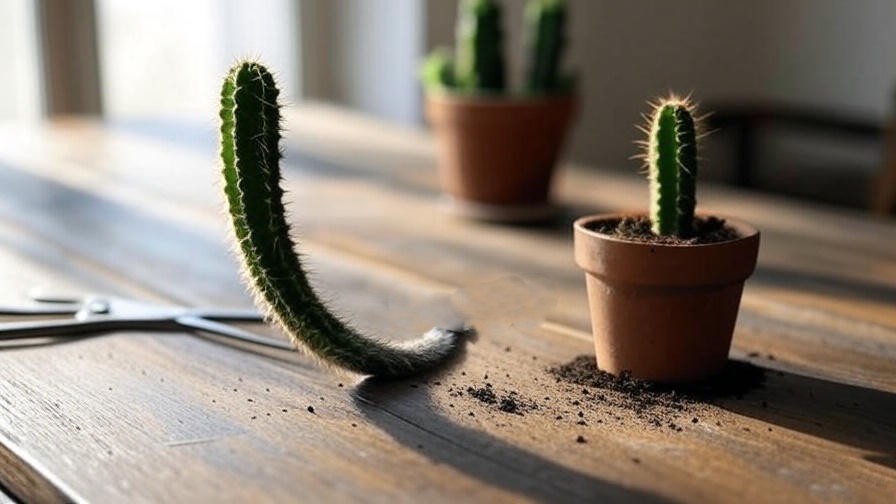
Step-by-Step Propagation Guide
One of the joys of growing a monkey tail cactus is how easy it is to propagate, allowing you to share the plant with friends or expand your collection. The most effective method is through stem cuttings. Here’s a step-by-step guide:
- Select a Healthy Stem: Choose a mature, healthy stem at least 4–6 inches long. Avoid stems that are discolored or damaged.
- Make a Clean Cut: Use clean, sharp scissors or pruning shears to cut the stem just below a node. Sterilize your tools with rubbing alcohol to prevent infection.
- Allow to Callous: Place the cutting in a dry, shaded area for 2–3 days until the cut end forms a callous. This prevents rot when planted.
- Plant the Cutting: Fill a small pot with well-draining cactus soil. Insert the calloused end about 1 inch into the soil, ensuring it stands upright.
- Water Sparingly: Lightly water the soil, then wait until it’s dry before watering again. Place the pot in bright, indirect light.
- Monitor Rooting: Roots typically form within 2–4 weeks. Gently tug on the cutting to check for resistance, indicating root growth.
Tips for Propagation Success
For best results, propagate in spring or early summer when the plant is actively growing. Avoid overwatering during the rooting phase, as this can cause the cutting to rot. If your cutting isn’t rooting, check for adequate light or adjust the soil mix to ensure proper drainage.
Expert Insight: Patience is key. Resist the urge to overwater or disturb the cutting while it establishes roots. A small dose of rooting hormone can speed up the process but isn’t necessary for this hardy cactus.
Styling and Displaying Your Monkey Tail Cactus

Creative Display Ideas
The monkey tail cactus’s trailing stems make it a natural fit for creative displays. Here are some ideas to showcase its beauty:
- Hanging Baskets: Suspend your cactus in a woven or macramé basket to let its tails cascade dramatically. This is perfect for patios, balconies, or living rooms.
- High Shelves: Place it on a bookshelf or floating shelf to create a waterfall effect, adding texture to your space.
- Mixed Succulent Arrangements: Pair it with other succulents like echeveria or haworthia for a desert-inspired vignette. Use a wide, shallow pot to create a mini cactus garden.
Choose planters in neutral tones like terracotta, white, or matte black to complement the cactus’s soft, green stems. For a modern look, try geometric ceramic pots or concrete planters.
Seasonal Decor Tips
The monkey tail cactus is versatile enough to fit into seasonal decor. In spring, pair it with pastel-colored pots for a fresh, airy vibe. During the holidays, wrap the pot in burlap or add small, non-invasive decorations like fairy lights to create a festive yet minimalist display. Its boho-chic aesthetic also makes it a great fit for earthy, natural decor themes year-round.
Pro Tip: Avoid placing heavy decorations directly on the cactus stems, as they can damage the delicate spines.
Common Problems and How to Fix Them
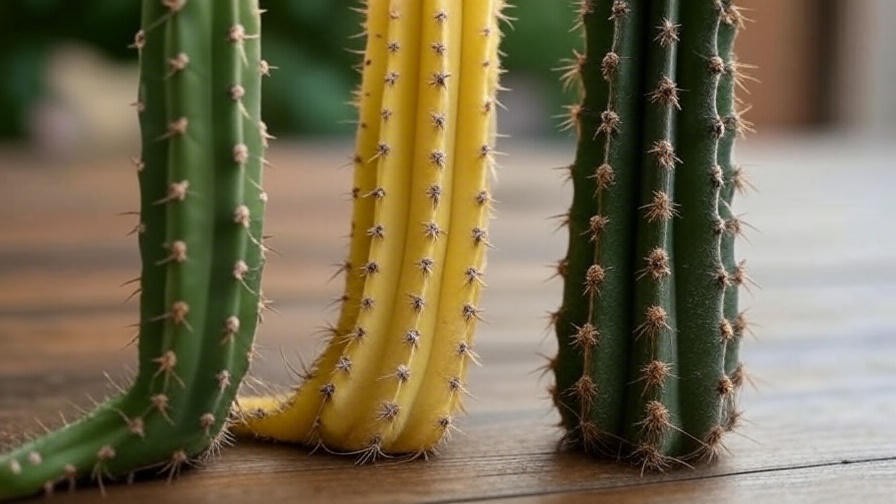
Pests and Diseases
While the monkey tail cactus is relatively pest-resistant, it can occasionally attract common houseplant pests like mealybugs, spider mites, and scale. Mealybugs appear as small, white, cottony masses on the stems, while spider mites leave fine webbing and stippled marks. Scale insects look like small, brown bumps clinging to the plant.
Prevention and Treatment:
- Regular Inspections: Check your cactus monthly for signs of pests, especially in hidden crevices where stems overlap.
- Natural Remedies: For minor infestations, wipe the affected areas with a cotton swab dipped in 70% rubbing alcohol. For larger issues, apply neem oil or insecticidal soap, ensuring thorough coverage of the stems.
- Isolation: Quarantine the affected plant to prevent pests from spreading to other indoor plants.
The primary disease risk for monkey tail cacti is root rot, caused by overwatering or poor drainage. Symptoms include a soft, mushy base or blackened roots. To address root rot, remove the plant from its pot, trim away affected roots with sterilized scissors, and repot in fresh, dry cactus soil. Allow the plant to recover in bright, indirect light with minimal watering for 1–2 weeks.
Expert Tip: To prevent fungal issues, ensure good air circulation around your cactus and avoid letting water sit on the stems or soil surface.
Troubleshooting Growth Issues
If your monkey tail cactus isn’t thriving, it may be signaling specific care issues. Here are common problems and their solutions:
- Yellowing or Soft Stems: Often a sign of overwatering. Check the soil and roots for excess moisture. If the soil is soggy, repot the cactus in fresh, well-draining mix and reduce watering frequency.
- Shriveled or Wrinkled Stems: Indicates underwatering or insufficient light. Gradually increase watering (following the soak-and-dry method) and move the plant to a brighter location.
- Lack of Growth or Flowering: This can result from inadequate light, nutrient deficiency, or a pot that’s too small. Ensure the cactus gets 6–8 hours of bright, indirect light daily, fertilize monthly during the growing season, and repot if the plant appears root-bound.
Pro Tip: Keep a care journal to track watering, fertilizing, and light conditions. This helps identify patterns and adjust care before issues escalate.
Advanced Care Tips for Experienced Growers
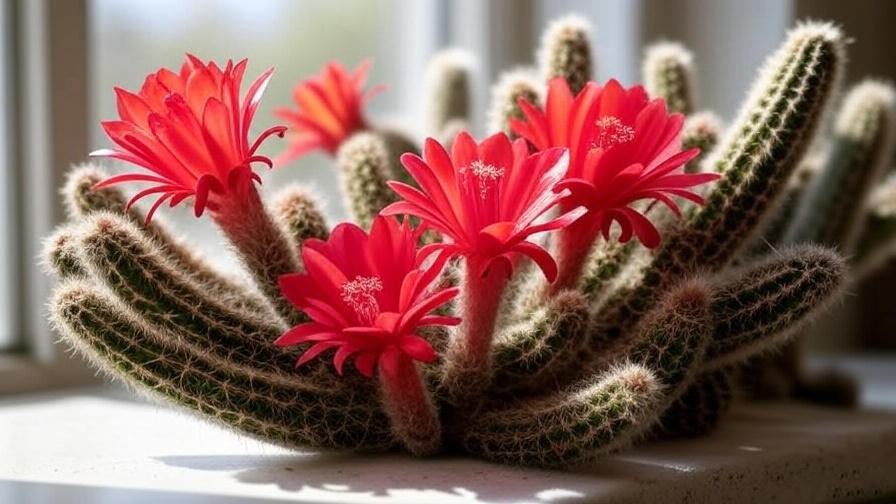
Encouraging Blooms
One of the most rewarding aspects of growing a monkey tail cactus is its potential to produce vibrant red or pink flowers in spring or summer. However, flowering typically occurs only in mature plants under optimal conditions. To encourage blooms:
- Maximize Light Exposure: Provide as much bright, indirect light as possible. A grow light can supplement natural light in dim environments.
- Induce Mild Stress: Slightly reduce watering in late winter to mimic the plant’s natural arid conditions, which can trigger blooming.
- Ensure Maturity: Younger plants may take 2–3 years to reach flowering age, so patience is essential.
When blooms appear, they add a striking contrast to the cactus’s fuzzy green stems, making it a showstopper in any collection. Avoid moving the plant during blooming to prevent bud drop.
Repotting and Long-Term Maintenance
Repotting is necessary every 2–3 years or when the cactus becomes root-bound, indicated by roots circling the pot or stunted growth. Follow these steps for safe repotting:
- Prepare Supplies: Use a slightly larger terracotta pot with drainage holes and fresh cactus soil mix.
- Remove the Plant: Gently tap the pot to loosen the cactus, supporting the stems to avoid breakage.
- Inspect and Trim: Check roots for rot or damage, trimming away any unhealthy sections with sterilized scissors.
- Repot: Place the cactus in the new pot, filling with soil and ensuring it’s stable. Water lightly after 3–4 days to allow the plant to settle.
For long-term maintenance, prune dead or damaged stem segments to maintain a tidy appearance. Use sharp, clean shears and allow cut ends to callous before replanting or discarding. Refresh the soil annually by removing the top layer and adding fresh mix to replenish nutrients.
Expert Insight: Repotting in spring aligns with the cactus’s growth cycle, promoting faster recovery and new growth.
FAQs About Monkey Tail Cactus Care
To address common reader questions and boost the article’s searchability, here are expert-backed answers to frequently asked questions:
- Is the monkey tail cactus toxic to pets?
No, the monkey tail cactus is non-toxic to cats, dogs, and other pets, according to the ASPCA. However, its spines can cause minor irritation if chewed, so keep it out of reach of curious animals. - How fast does a monkey tail cactus grow?
Growth is moderate, with stems extending 6–12 inches per year under ideal conditions. Factors like light, water, and nutrients influence growth rate. - Can I grow a monkey tail cactus indoors year-round?
Yes, it’s well-suited for year-round indoor growth, provided it receives adequate light and proper care. In colder climates, protect it from drafts and maintain temperatures above 50°F (10°C). - Why is my monkey tail cactus turning brown?
Browning can result from sunburn, overwatering, or pest damage. Assess light exposure, check soil moisture, and inspect for pests to pinpoint the cause and apply the appropriate fix.
These FAQs align with common search queries, enhancing the article’s relevance and authority.
Why the Monkey Tail Cactus Is a Must-Have for Plant Lovers
The monkey tail cactus is more than just a plant—it’s a statement piece that brings texture, personality, and low-maintenance charm to any indoor space. Its trailing, fuzzy stems make it a versatile addition to hanging baskets, shelves, or mixed succulent arrangements, while its resilience makes it perfect for beginners and busy plant parents. With the right care—bright light, well-draining soil, and minimal watering—you can enjoy a thriving cactus that adds a touch of desert elegance to your home.
Whether you’re drawn to its quirky appearance or its ease of care, the monkey tail cactus is a rewarding choice for any plant enthusiast. Use the tips in this guide to cultivate a healthy, stunning cactus and share your journey with fellow plant lovers. Have questions or tips of your own? Drop them in the comments or share your monkey tail cactus photos on social media to inspire others!
Conclusion
The monkey tail cactus is a true gem for indoor plant enthusiasts, blending quirky charm with effortless care. Its trailing, fuzzy stems bring a unique texture to any space, from cozy apartments to modern offices, while its low-maintenance nature makes it ideal for beginners and busy plant parents. By following the expert tips in this guide—providing bright, indirect light, well-draining soil, minimal watering, and occasional fertilizing—you can cultivate a thriving cactus that becomes a focal point in your home. Whether you’re propagating new plants, troubleshooting issues, or styling it in a hanging basket, the monkey tail cactus offers endless opportunities to flex your green thumb.
Ready to add this desert beauty to your collection? Start with the care strategies outlined here, and you’ll be rewarded with a stunning, healthy plant that sparks joy for years to come. Share your monkey tail cactus journey in the comments below or tag us on social media to inspire fellow plant lovers. Happy growing!


